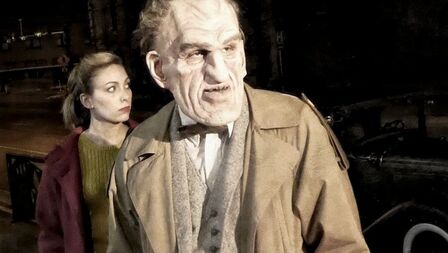 Being a horror fan often means delighting in the dark, grotesque, or otherwise unsettling sides of life and art that most other people might shy away from... We often see ourselves in the monsters as they lumber across the screen wreaking havoc or vengeance on their hapless victims. Dedicated monster kids might have favorites, and accumulating knowledge on preferred creatives’ lives comes with the territory. Still, the beauty of a horror well made is that we forget the people behind the masks and are left with only the terror they instill in us. Classic film occasionally leant hard on disfigured or otherwise abnormal-looking actors to bring the sense of menace to their villainous figures, generating careers particularly in the B-horror arena. Instilling unease isn’t just about the killer running rampant through an abandoned area, weapon at the ready and target in sight, however. It’s also in the atmosphere of the area itself, and the longest lasting horror touchstones all have some visual element that sets them apart for superfans. One of the best examples of a well-crafted atmosphere is Tobe Hooper’s original Texas Chain Saw Massacre, a film routinely considered to be far bloodier than it is, simply because watching it catapults you headfirst into one of the grimiest houses and hottest Texas summers put to screen. If we feel claustrophobic and filthy, chances are our brains will fill in the details even when the film itself only hints. Joe M. O’Connell’s documentary Rondo and Bob, playing this week at 2022’s Panic Fest, explores the lives of two distinctive figures in genre film at two entirely separate but connected periods in time: 1930s journalist-turned-actor Rondo Hatton and 1970s art director/aspiring filmmaker/actor Robert Burns. Prolific in his own right and, judging by the documentary, sought after for his impressive crafting skills and ability to work on the smallest budgets imaginable, Rondo and Bob focuses predominantly on Burns’ time and influence as art director on Texas Chain Saw Massacre, and on his obsession with Rondo Hatton, aka “The Creeper”. Hatton is perhaps best known in the horror world by his extraordinary facial disfigurement, caused by a hormonal condition called acromegaly which leads to enlargement of the bones of the head and soft parts of the hands and feet and consequently seemed to lend him, in the eyes of Universal Studios, to the role of potential iconic villain. While his cult popularity seems assured now, various interviewees of Rondo and Bob thought Robert Burns’ obsession with the man led him to be the leading Rondo Hatton expert and, according to Hatton’s wife Mae, kept him out of obscurity. Bob Burns may be an unforgettable talent himself—I was delighted to hear I was not the only one who venerated his work without knowing his name—but the alignment of the two of them and the love he so clearly had for a man routinely labeled “the ugliest man” in Hollywood before he was recognized for anything else turns Rondo and Bob into an altogether heartwarming—and occasionally heartbreaking—experience. The film puts on full display not only the importance of pursuing your passions with whatever tools you can manage, but just how much of an impact the things we love have on us. “Creatives unearthing forgotten creatives” is quickly becoming one of my favorite niche areas of genre fandom and exploration. I first encountered it with Mallory O’Meara’s in-depth literary personal love letter/biography of Creature from the Black Lagoon Gill Man designer Millicent Patrick, and Rondo and Bob shows the same dedication to both of its sources, tragically lost to conditions beyond their control but, now, most assuredly never forgotten. Where Rondo was thought—and partly considered himself—to be unable to fully emotionally connect with anyone outside himself, Bob Burns seemed absolutely effervescent with passion. Where Hatton embodied villainy onscreen and tenderness offscreen, Burns could make your skin crawl with just a dining room set and would frequently collide over his need for control in his many creative pursuits. It fits, then, that one should so devotedly seek out the other and keep the spark of his talent and humanity alive. Mae Hatton might have been right in her anxieties that her husband was at risk of being forgotten before Bob Burns showed up to interview her about him, but now his name is inexorably tied to an award based around passionate fandom, and Rondo and Bob is sure to gain both men many more devotees. By Katelyn Nelson
0 Comments
Leave a Reply. |
Archives
March 2023
|

 RSS Feed
RSS Feed